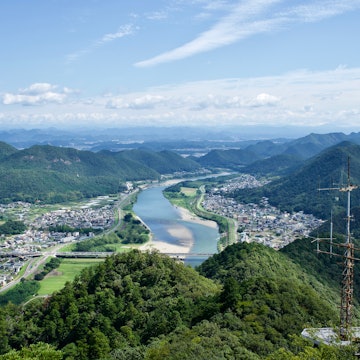

People emerge from the metro stop in Gangnam, Seoul – a city that has one of the best public-transport networks in the world. Antyony Wallace/AFP via Getty Images
There’s so much to see and do in Seoul that you should count on covering some ground as you explore.
Luckily, Seoul’s clean, punctual and accessibility-focused public transport network ranks among the best in the world, and getting around the capital of South Korea is smoother than ever thanks to several smartphone apps that provide real-time information and integrated fare payment.
KakaoMap is available in English and can help you plan your journey from door to door, covering everything from when the next bus will come to the most efficient train car to board. Seoul’s subway trains and buses all have free wi-fi, so you can keep track of your journey online even without a SIM card.
From buses and bicycles to taxis and trains and your own two feet, here’s the insider scoop on the best ways to get around Seoul.
Start with a transport pass, which brings convenience and savings
While Seoul’s buses and trains are operated by several different companies, you can pay for journeys with all operators with a transport pass. There are three to choose from: NAMANE, T-money and Cashbee.
You can get a physical NAMANE card from a kiosk at transport hubs, or use a digital one via the app. Top it up and use it across public transport, as well as at some retailers. You can purchase a T-money and Cashbee card at convenience stores as well as transport hubs: just top them up as you go to use on any public transport and affiliated retailers. (Keep in mind that T-money is more widely accepted in stores than Cashbee.)
While it is possible to buy a single-ride ticket at the station each time or pay in cash on the bus, this is uncommon. Transport cards can be used in taxis, subways and buses all over South Korea, and visitors can buy T-money in conjunction with other special deals for foreign tourists.
Because many of the cards have a special design or theme (such as pictures of K-pop group BTS), many choose to keep the card as a souvenir. If you don’t want this, you can get a refund for the cost of the card at Incheon International Airport when you leave the country.

The metro is the fastest and most affordable way to get around Seoul
With 22 subway lines making 302 stops across the city, the Seoul Metro is the most efficient way to get around the city. To navigate all the lines and transfer points, download the Metro app for iPhone or Android; you should find the entire process quite straightforward. Each station has English-language signs, and stops are announced in Korean, English, Chinese and Japanese.
Adult fares start at ₩1400 (US$0.97) per ride with a transport pass; each fare allows for up to four transfers to another subway bus or line within 30 minutes. If you’re changing between one subway line and another, you generally don’t tap out to make transfers. Platform screens detail what trains are due to arrive and depart, and exit signs detail major adjacent landmarks.
The subway closes between midnight to 5:30am, though exact times vary by line. Check the app for precise information.
Brush up on subway etiquette
The unspoken but universally followed rules of etiquette are a big part of what makes Seoul’s subway work so smoothly. Most people line up outside the train doors and enter in an orderly manner. Train cars usually have reserved seats for the elderly, pregnant passengers and travelers with disabilities. Visitors sometimes use these seats when available, but it’s considered good manners to leave these places empty for those in need.

Seoul’s buses can take you anywhere in the city
While buses may take a little longer than the metro, they can be a great option if you’re traveling to a more residential area or if your subway route requires more than one transfer. Plus, they let you watch the city go by as you get from point A to point B.
Bus stops generally display routes in both Korean and English. A digital screen shows when the next bus arrives, and indicates how crowded the bus is. (The seat-availability signage is only in Korean, but it’s color-coded: “comfortable” is usually white, “average“ is yellow and ”busy“ is red.) Bus stop signs also give weather and air quality information; some bus stops even have seats that warm up in colder weather.
Seoul has five types of buses, each color-coded to indicate their purpose. Green and blue buses cover cross-town routes, and an adult ticket costs ₩1500 (US$1.04). The small green local buses known as maeul are about half the size of the regular green buses, and they stick to just one neighborhood or district, at a fare of ₩1200 (US$0.83). Red buses travel between Seoul and outer regions and cost ₩3000 (US$2.08). Yellow or circulator buses loop around popular tourist destinations such as Namsan and Myeong-dong and cost ₩1400 (US$0.97).
You are allowed up to four transfers either to the subway or another bus for free within 30 minutes. Typically, you tap in at the front door when you enter the bus and tap out at the back door when you exit. Remember to tap out to secure your free transfers and discounts.
The queuing system is pretty loose for the bus: during rush hour, passengers often enter through the back door or exit through the front door – even though some bus drivers frown upon this practice. Night buses are indicated by an N before the number, and the fare is ₩2500 (US$1.73). The etiquette of avoiding seats for the elderly, pregnant and travelers with disabilities does not apply as it does on the subway, though you’ll be expected to give up your seat if someone needs it.

Hail a taxi for late-night journeys
Seoul cabs come in many different shapes and sizes, the most common being silver or orange mid-size sedans that take a maximum of four passengers. Cabs charge a base fare of ₩4800 (US$3.33), plus increments of ₩100 (US$0.07) for every eighth of a mile. (The incremental price increases a little between 10pm and 4am.) You can pay with a credit card, cash or transport card.
There are a few Korean rideshare apps, but you might need a valid Korean phone number to use them. If you have a local number, download Kakao T, a popular app that’s available in English. Cabs operated by International Taxi Service can be booked on the website or via phone or email, but reservations are required 24 hours in advance. Otherwise, you can hail cabs on the street.
Even if you are confident in your ability to pronounce your destination, it’s best to show a cab driver the name of your destination written in Korean since some places have similar names (such as Sinchon Station and Sincheon Station). If you need to explain your route in detail to your driver, you can call a free interpretation hotline; the number is usually indicated on a sticker on the window side of a cab. If you don’t see it for some reason, try using the BBB app, which is staffed by volunteers and available on both Apple and Android.
Be aware that many cab drivers are reluctant to take on short journeys and sometimes reject passengers for this reason. To avoid this, locals often get in and shut the door before telling the driver where they’re going.
We don’t recommend driving your own car in Seoul
Traffic in Seoul can be sheer gridlock, and parking is cutthroat even by the standards of other huge cities. Although you can rent a car with an international driver’s license, we don’t recommend this for a short visit.

See the city up close on a bike
Seoul has a handful of bike-share schemes. The best-known and most accessible to non-Koreans is Ttareungi, with its distinctive white-and-green bicycles. Visitors can create an account online and download the Seoul Bike app to use the system. You can purchase hourly, daily or yearly passes; bicycles can be rented at one station and returned at another.
There are some useful dedicated cycling paths – including the Hangang River Cycling Trail, which follows the Han River through the city – but many roads do not have a separated bike lane, and cyclists often have to share the sidewalk with pedestrians. Cyclists are required to dismount and walk across pedestrian crosswalks; although this rule is not vigorously enforced, ignoring it may make you liable in the event of an accident.

Walking is often the best option
Since Seoul is an incredibly dense city – with shops, restaurants and cultural sights often packed tightly together – getting around on foot has major rewards. A walk of only 1.3km (0.9 miles) will take you from Gyeongbokgung Palace (the largest of the capital’s five grand palaces) to Changdeokgung Palace (often considered the most beautiful of the lot). Between these two sights lie dozens of lesser-known attractions and cafes, such as the Arario Museum, Cafe Onion and Seoul Museum of Craft Art – all of which you’d miss if you took a cab, bus or train.
Accessible transportation in Seoul
With audio and visual information systems, elevators, Braille tiles, accessible turnstiles and bathrooms at almost all subway stations across the city, Seoul Metro is considered “mostly accessible” by organizations such as WheelchairTravel.org. If the elevators aren’t working, approach an attendant at the station to help you with a wheelchair lift to the train platform. Priority seating is available for travelers with disabilities, and train cars with wheelchair spaces are marked with a large green wheelchair decal on the floor.
Priority seating is also available on all of Seoul’s buses, almost all of which have a ramp or a floor that can be lowered for those with mobility needs. For more information about accessible sightseeing and calling wheelchair-accessible taxis, check out Seoul Danurim, an accessible-travel organization.















